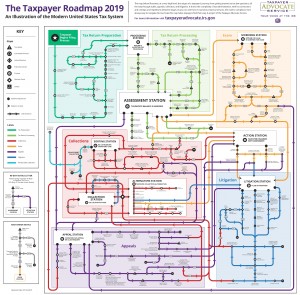One of the things I love about living in Las Vegas is not dealing with the Southern California traffic. I remember running into a horrendous traffic jam at 2 a.m. I remember the ten mile drive that took two hours. I don’t miss that in the least. Yes, there’s some traffic here in Las Vegas–I complain when my commute home takes twenty minutes instead of the usual twelve minutes–but it’s really benign when compared to Los Angeles.
I bring this up because the Taxpayer Advocate released a “roadmap” of what happens with a tax return. Here it is:
There are some comments I’d like to make about this:
1. Yes, our tax system is that convoluted. We should have a simple, straightforward system. Our current Tax Code reminds me of differential equations (and yes, I took that in college).
2. There are important steps that are left out of the roadmap. One of the items listed in “Tax Return Processing” is IRS Issues Math Error Notice. When I think of a math error, I think of 2 + 2 = 5. Those kinds of math errors are appropriate for a math error notice. However, one of my clients just received a math error notice where the IRS inserted a $300 penalty for no particular reason. That’s not appropriate for a math error notice (at least, I don’t think it is), yet if my client didn’t write the IRS within 30 days of receiving that notice it would be next to impossible to have that corrected. Indeed, the Taxpayer Advocate has, in the past, complained about math error notices.
3. The equivalent of traffic jams do occur. One of the current issues taxpayers and practitioners face is slow response time on the IRS reading its mail. Consider my client’s response to the math error notice. She received the notice on July 10th, and on July 11th mailed the response (using certified mail, return receipt requested). It was received on July 13th. The average IRS response time for reading correspondence is 14 weeks. That means it will likely be November 1st before my client receives a response to the erroneous penalty on a math error notice. And suppose a second letter is needed (which happens). The lack of timely responses by the IRS negatively impacts all taxpayers (and the IRS). I have a second client who received a late filing penalty for filing a tax return without an extension. The extension was filed, but it wasn’t processed until after the tax return was processed! That client had to file a request for abatement for the penalty. Here’s a situation where the IRS’s internal systems should have automatically abated the penalty, yet my client must mail another piece of paper to the IRS, wait 14 weeks for it to be read, and hope that the agent who reads it understands that this was an IRS error.
4. The IRS’s automated systems hurts “edge-case” taxpayers. My mother is not that computer literate. Yet she is supposed to pay her taxes (like all of us). Now, she happens to have a son who is a tax professional, but what if she didn’t? Would she really be able to determine how much of her social security is taxable? Or how to compute the new Section 199A deduction on her dividends that qualify for that deduction?
5. Did I mention that the Tax Code (and how it works) is far too complex? I’m pretty sure I did.
Most of the blame does not fall to the IRS; it falls to Congress, which enacts the laws that have resulted in this mess. Additionally, Congress has not adequately funded the IRS. These are issues that need to be resolved, but cannot be resolved by the IRS.
